I can’t believe I’m over halfway done with my program here in Kiev. I feel like I’m finally starting to know my way around the city but there’s still so much more to explore. While I do a lot of exploring on my own with friends, my school also provides me with excursions on Saturday mornings. Yesterday morning, we visited Софийский собор (Saint Sofia Cathedral), which is located several blocks from Золотые Ворота (Golden Gates), the metro stop near my school.
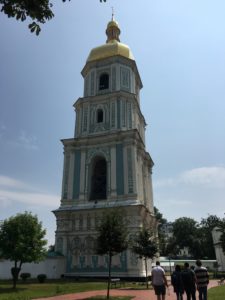
Saint Sofia Cathedral was founded in Kiev in 1011 by Yaroslav the Wise during the reign of his father, Vladimir the Great, Grand Prince of Kievan Rus’. Vladimir the Great brought Eastern Orthodox Christianity to Ukraine at the end of the 10th century, and named Saint Sofia Cathedral after the Hagia Sophia Cathedral in Constantinople (present-day Istanbul). The name “Sophia” means “wisdom” in Greek. [Note: “Sofia” is the Cyrillic transliteration, “Sophia” is the Greek transliteration]
One of the most interesting aspects of Saint Sofia is the architecture. I was raised Roman Catholic, but didn’t know very much about Eastern Orthodox Christianity before coming to Kiev. The Eastern Orthodox tradition of iconography and religious symbolism is exemplified by Saint Sofia Cathedral, where every inch of the interior is covered in frescos and mosaics. While the original mosaic tile floor inside the cathedral has not survived except for in a few places, I can only image how breathtaking the architecture would have been in its prime.
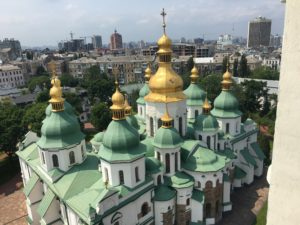
On the walls and the ceiling, the iconography is partly 11th-century fresco, and partly 18th-century oil painting due to restoration efforts. However, the difference between these mediums is apparent and it’s amazing how bright the frescos are given their history (the Mongols sacked Kiev in the 13th century and the cathedral was damaged in the 16th century during attempts at unification of the Catholic and Orthodox churches in Ukraine). However, because Saint Sofia Cathedral is a UNESCO World Heritage site, no photography of the interior is allowed. I did, however, manage to sneak a picture of a modern art exhibit located in the cathedral.
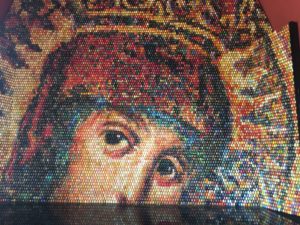
Stalin planned to destroy Saint Sofia in the 1930s during the Soviet anti-religious campaign, but the start of World War II saved the cathedral from destruction. However, located at the opposite end of the street from Saint Sofia is St. Michael’s Golden-Domed Monastery, which was destroyed in 1934 and rebuilt in 1991 after the fall of the Soviet Union and Ukrainian independence.
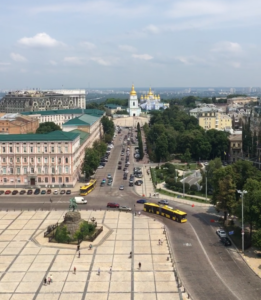
While Saint Sophia is now a museum and no longer an active church, St. Michael’s belongs to the Ukrainian Orthodox Church of the Kyivan Patriarchate, one of the three major denominations of Eastern Orthodox Christianity in Ukraine. St. Michael’s is dedicated to Saint Michael the Archangel, who is the patron saint of Ukraine.
Generally the trend worldwide seems to be that younger generations are becoming less religious than their parents, but I think it is important to recognize the significance of religion to the Ukrainian identity. Churches such as Saint Sofia and St. Michael’s seem to not only be religious symbols but also contribute to the political and national identity of Ukraine.
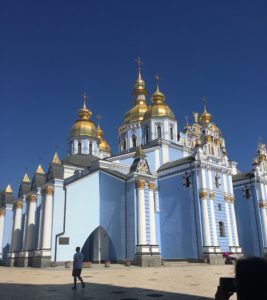
For example, at the center of Kiev in Майдан Незалежности (Independence Square), there is a statue of Saint Michael the Archangel on top of one of the former medieval gates to the city, facing the victory column that celebrates Ukrainian independence. As I mentioned in a previous post, Майдан Незалежности was the location of the 2014 protests known as the Revolution of Dignity, which overthrew the Ukrainian government and ousted former President Viktor Yanukovych. While religion may not hold the central role that it once did in the identity of medieval Kiev, it is still an important aspect of understanding the culture and identity of modern Ukraine.